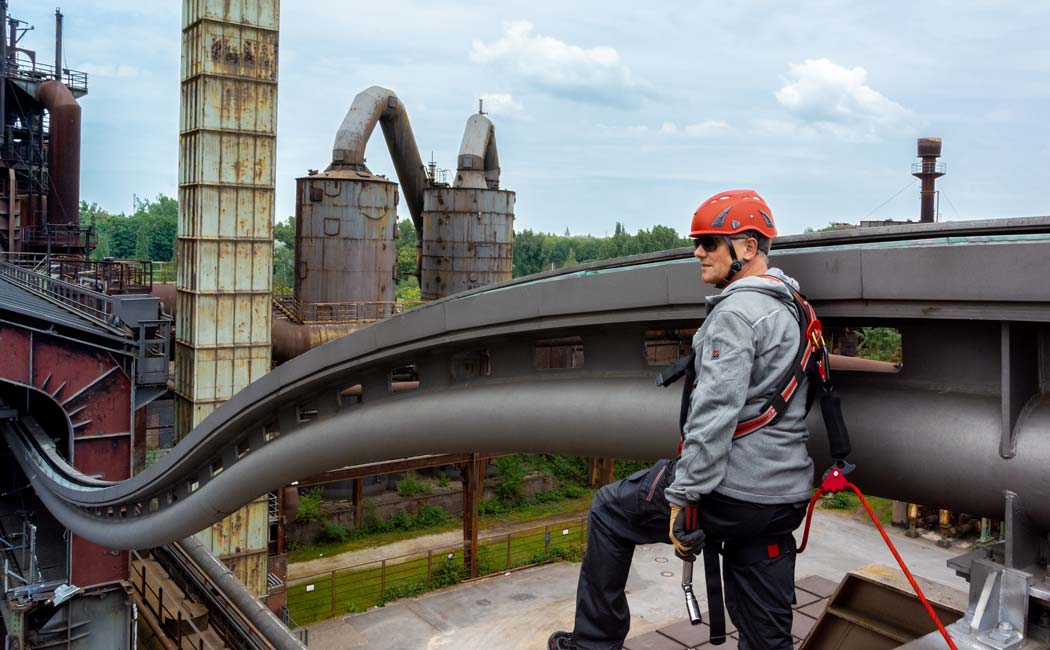- General terms
- Fall danger zone
- Falling edge
- Fall arrest for individuals
- Working alone
- General type approval
- Anchorage device
- Anchorage option
- Working on mobile elevating work platforms
- Arresting system
- Fall-through resistant
- Single anchorage point (anchor)
- Familiarisation
- Enclosed space
- Flat roof safety system
- Risk assessment
- Suspension trauma
- Swing fall
- Rescue concept
- Retention system
- Secondary fall arrest system
- Roof safety hook
- Safety and Occupational Health Coordinator (German: "SiGeKo")
- Thermal isolation
- Anchorage device inspections
- Training
- abZ & DIBt
- DGUV - German statutory accident insurance
- Collective protection
- Standards & regulations
- PPE
- Safety systems
- Access Technology
General terms
Fall arrest for individuals
The term “fall arrest for individuals” refers not only to a range of organisational measures but also to technical devices and personal equipment designed to prevent individuals from falling.
In the professional context, fall arrest is regulated by laws, regulations and the rules set down by the employers’ liability insurance associations. All these different fall arrest regulations are aimed at protecting employees in various occupational groups from dangerous and often life-threatening falls. Typical areas covered by these rules and regulations include roof work, construction sites, working on facades or towers as well as industrial applications, such as assignments high up on cranes, crane ways and wind turbines. In this context, a fall is not only understood to be a fall onto a hard surface situated lower down but also crashing through a non-fall-through-resistant surface or falling into a substance and sinking. Further central concepts in the professional fall arrest sector include the fall distance and the falling edge.
Important fall arrest provisions
Depending on the field of work in question, resp. the trade or sector involved, the German statutory accident insurance association (DGUV) publishes various regulations, principles, rules and information on the implementation of the respective health and safety provisions. These rules are binding for the insured persons and often form the basis for respective insurance cover. Failing to observe these provisions can jeopardise this cover.
Many of these regulations are based on laws, provisions and standards, the scope of which extends beyond specific individual occupational groups. The most important regulations include:
- Act on the Implementation of Measures of Occupational Safety and Health (ArbSchG)
- Technical Rules for Workplaces / ASR A2.1 Protection against falls and falling objects, entering hazardous areas
- Technical rules for safety in the workplace (TRBS) 2121 Danger to individuals through falling
- DIN 4426 Equipment for building maintenance - safety requirements for workplaces and accesses - design and execution
- PPE Usage Regulation - PSA-BV: German ordinance concerning the minimum health and safety requirements for the use by workers of personal protective equipment at the workplace
- DGUV Provision 1 - Regulation for the prevention of accidents / principles of prevention
- DGUV Rule 112-198 The use of personal fall protection equipment
- DGUV Publication 212-515 Personal Protective Equipment
Order of priority when selecting a fall arrest system
All regulations on fall protection are consistent in that they all state that a collectively effective protective measure should be used wherever possible. Such systems protect individuals with no previous knowledge of how to handle special equipment. A typical example of such a collective protection system is a so-called lateral protection system, for example in the shape of a guard rail. However, in many fields of application, it is not necessary to install lateral protection, for example, when a roof surface is rarely accessed.
Quite often, the structure itself makes installing lateral protection impossible. In such cases, personal protective equipment (PPE) has to be used. As a rule, PPE equipment consists of a safety harness which is worn by the user and a connector. The connector links up a safety harness with an anchorage device.
However, PPE equipment and corresponding anchorage devices may only be used by trained employees.

